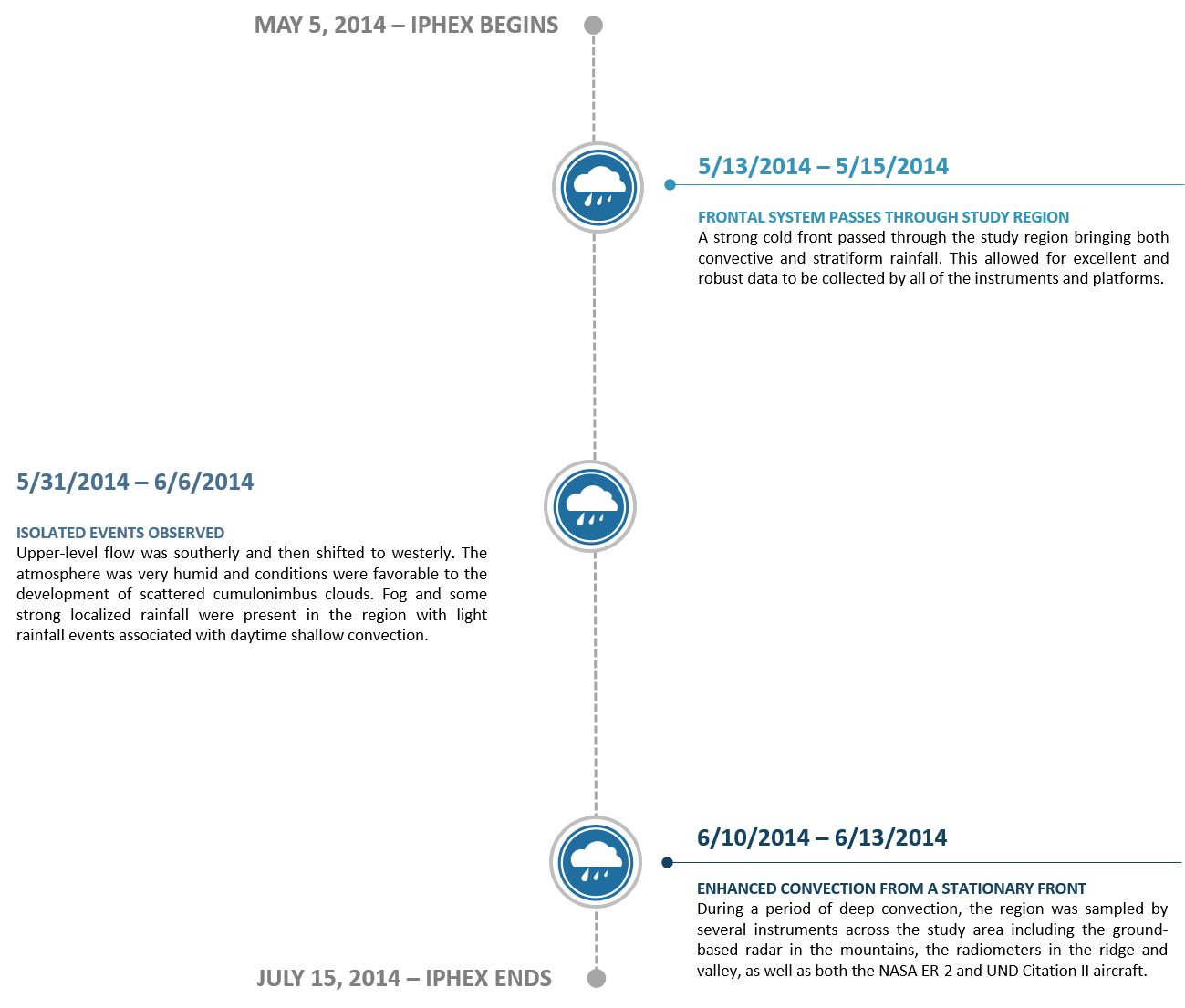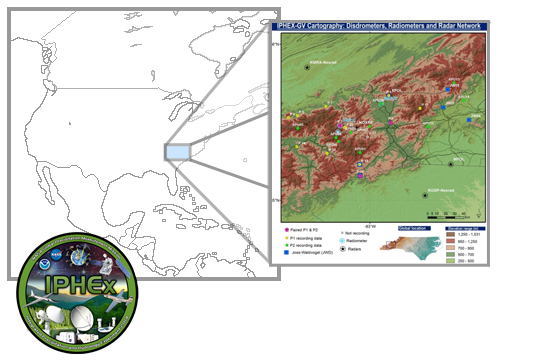Field Campaign Publication:
Barros, A. P., Petersen, W., & Wilson, A. M. (2016). Integrated Precipitation and Hydrology Experiment (IPHEx)/Orographic Precipitation Processes Study Field Campaign Report. Retrieved from https://www.osti.gov/servlets/purl/1248894
Barros, A. P., Petersen, W. A., Schwaller, M., Cifelli, R., Mahoney, K., Peters-Liddard, C., … Kim, E. (2014). NASA GPM-Ground Validation Science Plan. Retrieved from http://iphex.pratt.duke.edu
Erlingis, J. M., Gourley, J. J., Kirstetter, P.-E., Anagnostou, E. N., Kalogiros, J., Anagnostou, M. N., … Petersen, W. (2018). Evaluation of Operational and Experimental Precipitation Algorithms and Microphysical Insights during IPHEx. Journal of Hydrometeorology, 19(1), 113–125. https://doi.org/10.1175/JHM-D-17-0080.1
IPHEx Notable Publications:
Angulo-Martinez, M, and Barros, A.P. (2015). Measurement Uncertainty in rainfall kinetic energy and intensity relationships for soil erosion studies: an evaluation using PARSIVEL disdrometers in the Southern Appalachian Mountains. Geomorphology, 228, 28-40. https://doi.org/10.1016/j.geomorph.2014.07.036
Arulraj, M., and Barros, A.P., 2019: Improving Quantitative Precipitation Estimates in Mountainous Regions by Modeling Low Level Seeder-Feeder nteractions constrained by GPM DPR Measurements. Rem. Sen.of the Environ., 231, 111213. https://doi.org/10.1016/j.rse.2019.111213
Arulraj, M., Barros, A. P., Arulraj, M., & Barros, A. P. (2017). Shallow Precipitation Detection and Classification Using Multifrequency Radar Observations and Model Simulations. Journal of Atmospheric and Oceanic Technology, 34(9), 1963–1983. https://doi.org/10.1175/JTECH-D-17-0060.1
Barros, A.P. , and Arulraj, M. (2019): Remote Sensing of Orographic Precipitation. In Remote Sensing of Precipitation, Chapter 4.6, Elsevier (Pub.), in press.
D’Adderio, L. P., Porcù, F., Tokay, A., D’Adderio, L. P., Porcù, F., & Tokay, A. (2015). Identification and Analysis of Collisional Breakup in Natural Rain. Journal of the Atmospheric Sciences, 72(9), 3404–3416. https://doi.org/10.1175/JAS-D-14-0304.1
Dolan, B., Fuchs, B., Rutledge, S. A., Barnes, E. A., Thompson, E. J., Dolan, B., … Thompson, E. J. (2018). Primary Modes of Global Drop Size Distributions. Journal of the Atmospheric Sciences, 75(5), 1453–1476. https://doi.org/10.1175/JAS-D-17-0242.1
Duan,Y.,and Barros, A.P. (2017). Understanding how low-level clouds and fog modify the diurnal cycle of orographic precipitation using in situ and satellite observations. Remote Sensing, 9(9), 920.
https://doi.org/10.3390/rs9090920
Duan, Y., Petters, M. D., and Barros, A. P. (2019). Understanding aerosol-cloud interactions through modelling the development of orographic cumulus congestus during IPHEx, Atmos. Chem. Phys., 19, 1-25.
https://doi.org/10.5194/acp-19-1413-2019
Duan, Y., Wilson, A.M., and Barros, A.P. (2015). Scoping a Field Experiment: Error Diagnostics of TRMM Precipitation Radar Estimates in Complex Terrain as a basis for IPHEx 2014. Hydrol. Earth Sys. Sci., 19,1501-1520.
https://doi.org/10.5194/hess-19-1501-2015
Miller, D., Miniat,C.F., Wooten, R., and Barros, A.P. (2019). An Expanded Investigation of Atmospheric Rivers in the Southern Appalachian Mountains and their Connection to Landslides. Atmosphere, 10, 71.
https://doi.org/10.3390/atmos10020071
Porcacchia, L., Kirstetter, P. E., Gourley, J. J., Maggioni, V., Cheong, B. L., Anagnostou, M. N., … Anagnostou, M. N. (2017). Toward a Polarimetric Radar Classification Scheme for Coalescence-Dominant Precipitation: Application to Complex Terrain. Journal of Hydrometeorology, 18(12), 3199–3215. https://doi.org/10.1175/JHM-D-17-0016.1
Prat, O., and Barros, A. P. (2010a). Ground Observations to Characterize the Spatial Gradients and Vertical Structure of Orographic Precipitation – Experiments in the Inner Region of the Great Smoky Mountains , J. Hydrology.
https://doi.org/10.1016/j.jhydrol.2010.07.013
Prat , O., and Barros, A.P. (2010b). Assessing satellite-based precipitation estimates in the Southern Appalachian Mountains using raingauges and TRMM PR. Adv. Geosci., 25, 143–153.
https://doi.org/10.5194/adgeo-25-143-2010
Tao, J., and Barros, A.P. (2019). Multi-Year Surface Radiative Properties and Vegetation Parameters for Hydrologic Modeling in Regions of Complex Terrain – Methodology and Evaluation over the IPHEx2014 Domain. J. Hydrology-Reg. Studies, 22.
https://doi.org/10.1016/j.ejrh.2019.100596
Tao, J., Wu, D., Gourley, J., Zhang, S.Q., Crow, W., Peters-Lidard, C.,and Barros, A.P. (2016). Operational Hydrological Forecasting during the IPHEx-IOP Campaign- Meet the Challenge. J. Hydrology.
https://doi.org/10.1016/j.jhydrol.2016.02.019
Wilson, A. M., and Barros, A.P. (2014). An investigation of warm rainfall microphysics in the Southern Appalachians: orographic enhancement via low-level seeder-feeder interactions. J. Atmos. Sci., Vol. 5, No.5, 1783-1805.
https://doi.org/10.1175/JAS-D-13-0228.1
Wilson, A. M., & Barros, A. P. (2015). Landform controls on low level moisture convergence and the diurnal cycle of warm season orographic rainfall in the Southern Appalachians. Journal of Hydrology, 531, 475–493. https://doi.org/10.1016/J.JHYDROL.2015.10.068
Wilson, A. M., Barros, A. P., Wilson, A. M., & Barros, A. P. (2017). Orographic Land–Atmosphere Interactions and the Diurnal Cycle of Low-Level Clouds and Fog. Journal of Hydrometeorology, 18(5), 1513–1533. https://doi.org/10.1175/JHM-D-16-0186.1










